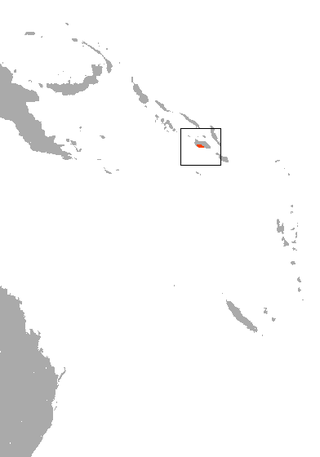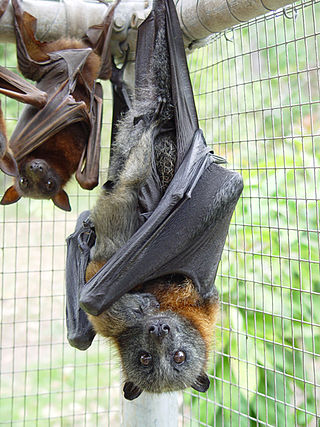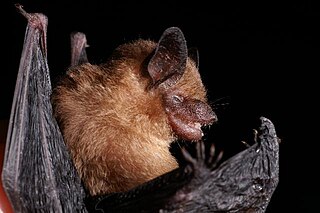
Megabats constitute the family Pteropodidae of the order Chiroptera (bats). They are also called fruit bats, Old World fruit bats, or—especially the genera Acerodon and Pteropus—flying foxes. They are the only member of the superfamily Pteropodoidea, which is one of two superfamilies in the suborder Yinpterochiroptera. Internal divisions of Pteropodidae have varied since subfamilies were first proposed in 1917. From three subfamilies in the 1917 classification, six are now recognized, along with various tribes. As of 2018, 197 species of megabat had been described.

The demonic tube-nosed fruit bat is a species of bat in the family Pteropodidae. It is endemic to Papua New Guinea. The holotype specimen was collected in 1979 on New Ireland, in the Bismarck Archipelago. It was described as a new species in 1983. The range of the species may extend to other islands, however the extent of the range is not presently known.

The lesser tube-nosed bat is a species of megabat in the family Pteropodidae. It is native to two of the Maluku Islands in northern Indonesia.

The Choco broad-nosed bat is a species of bat in the family Phyllostomidae. It is native to Colombia, Panama, and Ecuador, where it is found in the Choco region lowlands. It is threatened by habitat loss. In 2013, Bat Conservation International listed this species as one of the 35 species of its worldwide priority list of conservation.

The Bonin flying fox, Bonin fruit bat, or in Japanese Ogasawara giant bat is a species of flying fox in the family Pteropodidae. It is endemic to four islands in Ogasawara Islands, Japan. Its natural habitat is subtropical forests. It is threatened by habitat loss.

The blunt-eared bat or Peruvian crevice-dwelling bat is a species of bat in the family Molossidae. It is monotypic within the genus Tomopeas and subfamily Tomopeatinae. It is endemic to Peru, where it is considered critically endangered. It is threatened by habitat loss.

The Fijian monkey-faced bat Also known as Fijian flying fox or Fijian flying monkey, is a megabat endemic to Fiji. It was discovered in old-growth cloud forest on Des Vœux Peak, the second highest mountain peak on the island of Taveuni by William and Ruth Beckon in 1976, and is Fiji's only endemic mammal. It has recently been transferred from Pteralopex to its own monotypic genus Mirimiri.

The Bougainville monkey-faced bat or Bougainville flying monkey is a megabat endemic to Bougainville Island of Papua New Guinea and Choiseul Island of the Solomon Islands in Melanesia. It inhabits mature forests in upland areas, within the Autonomous Region of Bougainville and Bougouriba Province.

The montane monkey-faced bat or montane flying monkey is a megabat endemic to the Solomon Islands. It is listed as a critically endangered species. Due to its imperilled status, it is identified by the Alliance for Zero Extinction as a species in danger of imminent extinction. In 2013, Bat Conservation International listed this species as one of the 35 species of its worldwide priority list of conservation. Only one individual has ever been found.

The Guadalcanal monkey-faced bat or Guadalcanal flying monkey is a megabat endemic to Solomon Islands. It is listed as an endangered species. In 2013, Bat Conservation International listed this species as one of the 35 species of its worldwide priority list of conservation.

The Pteropodinae are a subfamily of megabats. Taxa within this subfamily are:

Rhogeessa is a genus of bats within the vesper bats family, Vespertilionidae.

The Aru flying fox is a Critically Endangered species of megabat found in the Aru Islands in Indonesia. It was described by Wilhelm Peters in 1867. It was formerly considered a subspecies of the black-bearded flying fox. The species is poorly known, and has not been encountered since the 19th century. It is classified as critically endangered by the IUCN and is listed on CITES appendix II.

Keast's tube-nosed fruit bat is a species of megabat in the family Pteropodidae found in Babar, Tanimbar, and the Kai Islands. It was named after Colin Keast.

The greater monkey-faced bat or greater flying monkey is a megabat endemic to Solomon Islands, Bougainville, in Papua New Guinea, and nearby small islands. It is listed as a critically endangered species and the population is decreasing. It is the largest monkey-faced bat.















